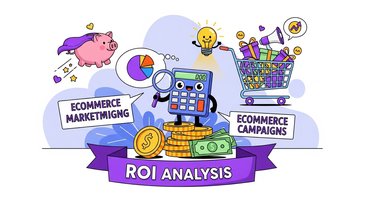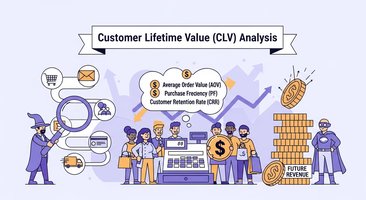Understanding and optimizing your gross margins isn't just about knowing which products make money—it's about building a sustainable, profitable ecommerce business that can weather market fluctuations and scale efficiently. With rising advertising costs, supply chain pressures, and increasing competition, mastering gross margin analysis has become essential for ecommerce success.
In this comprehensive guide, we'll explore how to conduct thorough gross margin analysis across products and channels, identify optimization opportunities, and leverage tools like Klavena to make data-driven decisions that boost your bottom line.
What Is Gross Margin Analysis?
Gross margin analysis is the systematic evaluation of the difference between your revenue and cost of goods sold (COGS), expressed as both dollar amounts and percentages. It reveals which products, channels, and customer segments generate the most profit after direct costs.
Gross Margin Formula:
- Gross Margin ($) = Revenue - Cost of Goods Sold
- Gross Margin (%) = (Revenue - COGS) / Revenue × 100
Unlike net profit, which includes all business expenses, gross margin focuses specifically on product profitability before operational costs like marketing, fulfillment, and overhead.
Why Gross Margin Analysis Matters for Ecommerce
For ecommerce businesses, gross margin analysis provides critical insights that drive strategic decisions:
Product Portfolio Optimization: Identify which products deserve more marketing investment and which should be discontinued or repriced.
Channel Performance: Understand how different sales channels (direct-to-consumer, Amazon, wholesale) impact profitability.
Pricing Strategy: Make informed decisions about price increases, discounts, and promotional strategies.
Inventory Management: Focus purchasing and storage resources on high-margin products.
Growth Planning: Ensure expansion efforts target profitable opportunities rather than just revenue growth.
The Components of Effective Gross Margin Analysis
1. Accurate COGS Calculation
Your gross margin analysis is only as good as your COGS data. For ecommerce businesses, COGS typically includes:
Direct Product Costs:
- Manufacturing or wholesale purchase price
- Raw materials and components
- Product packaging and labeling
- Import duties and tariffs
Variable Fulfillment Costs:
- Pick, pack, and ship labor
- Packaging materials for shipping
- Shipping costs to customers
- Payment processing fees
Hidden Costs Often Overlooked:
- Quality control and testing
- Product photography and content creation
- Returns processing and restocking
- Inventory shrinkage and damage
2. Product-Level Margin Analysis
Analyzing margins at the individual product level reveals crucial insights about your catalog's profitability distribution.
High-Margin Product Characteristics:
- Unique or proprietary designs
- Strong brand recognition
- Limited competition
- High perceived value
- Low shipping costs relative to price
Low-Margin Product Warning Signs:
- Commodity items with many alternatives
- Heavy or bulky products with high shipping costs
- Products requiring frequent returns or exchanges
- Items with short shelf life or high obsolescence risk
Using Klavena for Product-Level Analysis:
Klavena's advanced reporting capabilities allow you to track gross margins for each product variant automatically. The platform integrates with your ecommerce store to pull real-time sales data and COGS information, providing instant visibility into which products drive profitability.
Key features include:
- Automated margin calculations across all SKUs
- Trend analysis showing margin changes over time
- Comparison tools for evaluating similar products
- Alert systems for products falling below target margins
3. Channel-Specific Margin Analysis
Different sales channels often have varying cost structures and margin implications:
Direct-to-Consumer (DTC) Channels:
- Typically offer highest gross margins
- Full control over pricing and presentation
- Higher marketing costs but better customer data
- No marketplace fees or commissions
Marketplace Channels (Amazon, eBay, Etsy):
- Platform fees reduce gross margins (typically 8-15%)
- Built-in customer traffic but less control
- Standardized fulfillment options
- Competitive pricing pressure
Wholesale and B2B Channels:
- Lower gross margins but higher volume potential
- Reduced marketing and fulfillment costs
- Longer payment terms affecting cash flow
- Bulk shipping efficiencies
Retail Partnership Channels:
- Variable margin structures depending on terms
- Potential for co-op advertising arrangements
- Different return and inventory requirements
- Brand exposure benefits beyond immediate margins
Advanced Gross Margin Analysis Techniques
1. Cohort-Based Margin Analysis
Analyze how gross margins vary across different customer segments:
New vs. Returning Customers:
- First-time buyers often have lower margins due to acquisition costs
- Repeat customers typically generate higher margins
- Loyalty programs can improve long-term margin profiles
Geographic Segments:
- International shipping affects margins differently by region
- Local tax and duty implications
- Currency fluctuation impacts on imported goods
Purchase Behavior Segments:
- High-value customers may justify premium pricing
- Bulk purchasers might accept lower margins for volume
- Seasonal buyers require different margin strategies
2. Time-Based Margin Trends
Understanding how margins change over time helps predict future profitability:
Seasonal Patterns:
- Holiday seasons often see margin compression due to promotions
- Off-season periods may allow for margin recovery
- Weather-dependent products show predictable margin cycles
Product Lifecycle Impacts:
- New product launches typically start with higher margins
- Mature products face increased competition and margin pressure
- End-of-life products may require clearance pricing
Market Condition Effects:
- Economic downturns increase price sensitivity
- Supply chain disruptions affect COGS
- Competitive landscape changes impact pricing power
3. Margin Variance Analysis
Identify the root causes of margin fluctuations:
Cost Variance Factors:
- Supplier price changes
- Shipping rate fluctuations
- Currency exchange impacts
- Volume discount thresholds
Revenue Variance Factors:
- Promotional activity effects
- Mix shifts toward higher or lower-margin products
- Channel mix changes
- Customer behavior evolution
Benchmarking Your Gross Margins
Industry Standards by Category
Understanding typical gross margins in your industry provides context for performance evaluation:
Fashion and Apparel: 50-70%
- Higher margins on branded items
- Fast fashion typically at lower end
- Luxury brands command premium margins
Electronics and Technology: 15-25%
- Commodity electronics at lower end
- Specialized or innovative products higher
- Accessories typically higher margin than devices
Home and Garden: 40-60%
- Furniture and large items often lower due to shipping
- Small decorative items typically higher
- Seasonal products show significant variation
Health and Beauty: 60-80%
- Skincare and cosmetics at higher end
- Supplements and vitamins typically 50-70%
- Professional-grade products command premiums
Setting Margin Targets
Establish realistic margin targets based on:
Business Model Requirements:
- DTC brands typically need 60%+ gross margins
- Marketplace sellers may operate on 30-50%
- Wholesale businesses often work with 20-40%
Growth Stage Considerations:
- Early-stage businesses may sacrifice margins for market share
- Established brands should focus on margin optimization
- Scaling businesses need margins to support infrastructure
Competitive Positioning:
- Premium brands require higher margins to support positioning
- Value brands may accept lower margins for volume
- Niche products can often command higher margins
Optimization Strategies for Improving Gross Margins
1. Product Portfolio Optimization
High-Margin Product Development:
- Focus R&D on products with strong margin potential
- Develop proprietary features that justify premium pricing
- Create product bundles that increase average order values
- Introduce complementary high-margin accessories
Low-Margin Product Management:
- Discontinue consistently unprofitable items
- Renegotiate supplier terms for volume products
- Consider private labeling to improve margins
- Implement dynamic pricing based on demand
Using Klavena for Portfolio Decisions:
Klavena's product analytics help identify optimization opportunities by:
- Ranking products by contribution margin
- Highlighting underperforming SKUs for review
- Tracking the impact of pricing changes on overall profitability
- Providing recommendations for inventory investment
2. Supply Chain and COGS Optimization
Supplier Relationship Management:
- Negotiate better terms based on volume commitments
- Explore alternative suppliers for cost comparison
- Implement quality standards to reduce returns
- Consider vertical integration for key components
Inventory Management:
- Optimize order quantities to maximize volume discounts
- Reduce carrying costs through better demand forecasting
- Minimize obsolescence through improved product lifecycle management
- Implement just-in-time ordering where appropriate
Shipping and Fulfillment Efficiency:
- Negotiate better shipping rates through volume commitments
- Optimize packaging to reduce dimensional weight charges
- Consider regional fulfillment centers to reduce shipping costs
- Implement zone skipping strategies for distant customers
3. Pricing Strategy Optimization
Value-Based Pricing:
- Research customer willingness to pay for key features
- Implement tiered pricing for different value propositions
- Use psychological pricing techniques effectively
- Test price elasticity regularly
Dynamic Pricing Implementation:
- Adjust prices based on demand patterns
- Implement competitive pricing monitoring
- Use promotional pricing strategically to maintain margins
- Consider time-based pricing for seasonal products
Channel-Specific Pricing:
- Optimize pricing for each sales channel's characteristics
- Account for channel fees in pricing decisions
- Implement MAP (Minimum Advertised Price) policies
- Use exclusive products or bundles for different channels
4. Technology-Driven Margin Optimization
Automated Margin Monitoring:
Modern ecommerce businesses need real-time visibility into margin performance. Klavena's automated reporting provides:
- Daily margin tracking across all products and channels
- Alert systems for margins falling below thresholds
- Trend analysis to predict future margin challenges
- Integration with accounting systems for accurate COGS data
Predictive Analytics:
- Forecast margin impacts of pricing changes
- Predict seasonal margin variations
- Identify products at risk of margin erosion
- Model the profitability impact of new product launches
Implementing a Gross Margin Analysis System
1. Data Infrastructure Setup
Essential Data Sources:
- Sales transaction data from all channels
- Detailed COGS information by product
- Inventory levels and carrying costs
- Customer acquisition and retention costs
- Channel-specific fees and commissions
Data Quality Requirements:
- Standardized product categorization across systems
- Regular COGS updates reflecting current costs
- Accurate attribution of variable costs to products
- Consistent measurement periods and definitions
2. Reporting and Dashboard Creation
Key Performance Indicators:
- Overall gross margin percentage and trends
- Product-level margin rankings
- Channel performance comparisons
- Customer segment profitability analysis
- Margin variance from targets
Automated Reporting Features:
Klavena's comprehensive reporting suite includes:
- Executive dashboards with key margin metrics
- Product manager reports for optimization decisions
- Channel performance comparisons
- Exception reports for products requiring attention
- Trend analysis with predictive insights
3. Action Planning and Implementation
Regular Review Processes:
- Monthly margin review meetings
- Quarterly deep-dive analysis sessions
- Annual strategic planning incorporating margin targets
- Continuous monitoring of key margin drivers
Cross-Functional Collaboration:
- Product teams for development and pricing decisions
- Procurement teams for supplier negotiations
- Marketing teams for promotional strategy
- Operations teams for fulfillment optimization
Advanced Applications of Gross Margin Analysis
1. Customer Lifetime Value Enhancement
Understanding how gross margins vary by customer segment enables more sophisticated CLV calculations:
Margin-Adjusted CLV:
- Weight customer value by their typical product mix margins
- Account for channel preferences in CLV calculations
- Consider margin trends over customer lifecycle
- Optimize acquisition spending based on margin-adjusted CLV
2. Inventory Investment Optimization
Use margin analysis to guide inventory decisions:
Working Capital Allocation:
- Prioritize inventory investment in high-margin products
- Reduce safety stock for low-margin items
- Optimize reorder points based on margin contribution
- Consider margin impact in product discontinuation decisions
3. Market Expansion Strategy
Apply margin analysis to new market opportunities:
Geographic Expansion:
- Model margin impacts of international shipping costs
- Account for local tax and duty implications
- Consider currency hedging for margin stability
- Evaluate local fulfillment options for margin improvement
Channel Expansion:
- Assess margin implications of new sales channels
- Model the impact of channel-specific requirements
- Consider exclusive product development for high-margin channels
- Evaluate partnership opportunities for margin enhancement
Common Gross Margin Analysis Pitfalls
1. Incomplete COGS Accounting
Many businesses underestimate true product costs by overlooking:
- Variable fulfillment and shipping costs
- Return processing and restocking fees
- Quality control and customer service costs
- Inventory carrying costs and shrinkage
2. Static Analysis Approaches
Gross margins change over time, and analysis should account for:
- Seasonal variations in costs and pricing
- Product lifecycle impacts on margins
- Market condition changes affecting competitiveness
- Supply chain disruptions affecting COGS
3. Channel Attribution Errors
Properly attributing costs and revenues to channels requires:
- Accurate tracking of channel-specific fees
- Proper allocation of shared fulfillment costs
- Recognition of cross-channel customer journeys
- Consideration of channel-specific return rates
The Future of Gross Margin Analysis
1. AI-Powered Optimization
Emerging technologies are revolutionizing margin analysis:
- Machine learning algorithms for dynamic pricing
- Predictive analytics for margin forecasting
- Automated supplier negotiation systems
- Real-time competitive pricing intelligence
2. Integrated Business Intelligence
Modern platforms like Klavena are evolving to provide:
- Unified views across all business systems
- Real-time margin optimization recommendations
- Automated alert systems for margin protection
- Predictive modeling for strategic planning
3. Sustainability and Margin Integration
Growing focus on sustainable business practices affects margin analysis:
- Environmental cost accounting in COGS
- Sustainable packaging cost considerations
- Carbon footprint impacts on shipping decisions
- Consumer willingness to pay premiums for sustainability
Conclusion: Building a Margin-Optimized Business
Effective gross margin analysis is the foundation of profitable ecommerce growth. By implementing systematic approaches to measuring, analyzing, and optimizing margins across products and channels, businesses can make informed decisions that drive sustainable profitability.
The key to success lies in:
- Maintaining accurate, comprehensive cost data
- Implementing regular analysis and review processes
- Using technology to automate monitoring and optimization
- Taking action based on analytical insights
- Continuously refining approaches based on results
Tools like Klavena make sophisticated margin analysis accessible to businesses of all sizes, providing the real-time insights and automated reporting capabilities necessary for effective margin management in today's competitive ecommerce environment.
Remember, the goal isn't just to measure margins—it's to use that knowledge to build a more profitable, sustainable business that can thrive regardless of market conditions. Start with accurate data, implement systematic analysis processes, and take decisive action based on your insights.
Your gross margins are a reflection of your business's fundamental health and competitive position. By mastering margin analysis and optimization, you're not just improving today's profitability—you're building the foundation for long-term success in the dynamic world of ecommerce.





